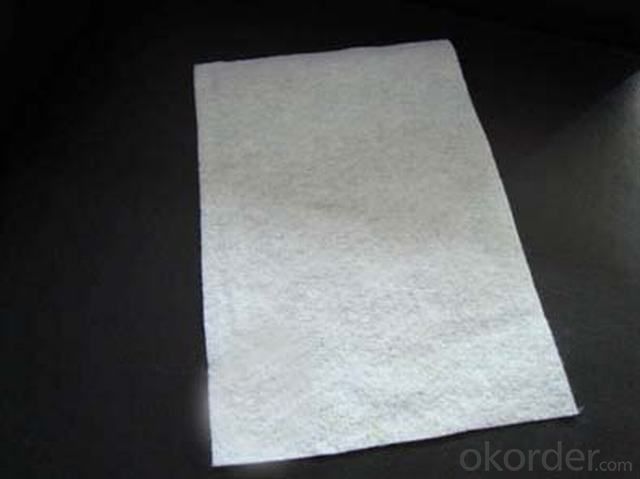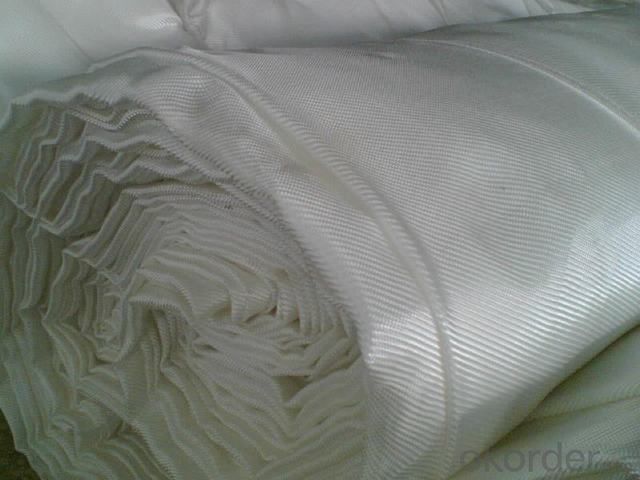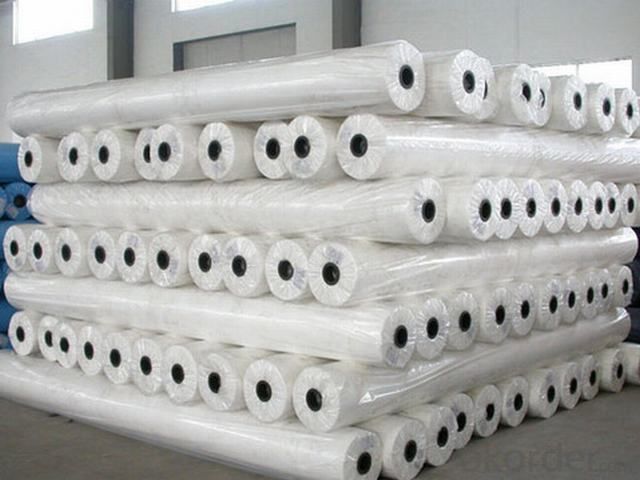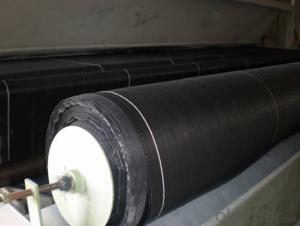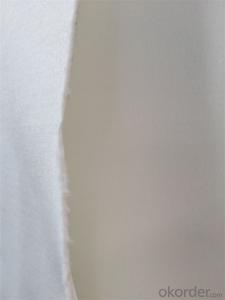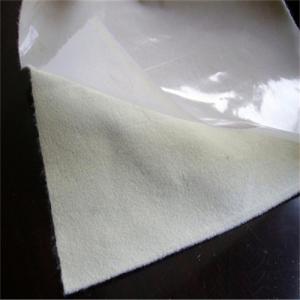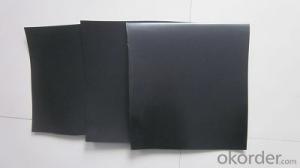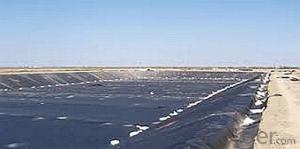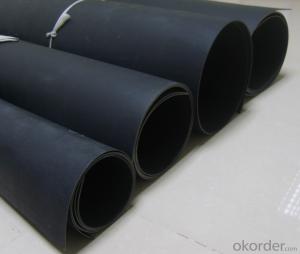Geotextil 4m Short Fiber and Geomembrane Composite Waterproofing Membrane
- Loading Port:
- Qingdao
- Payment Terms:
- TT or L/C
- Min Order Qty:
- 10000 m²
- Supply Capability:
- 10000 m²/month
OKorder Service Pledge
OKorder Financial Service
You Might Also Like
(1) Product introduction
Short fiber knitting geotextile takes the polypropylene fiber or the polyester fiber short fiber as the primary material, after blooms the pine ,to comb, disorderly, craft productions so on shop net, acupuncture to become.
(2) Product features
1. Net holes are easy foe blockage, since net structure formed by indefinite fiber has variable and motility.
2. It has high permeation and can keep good permeation under the pressure of earthwork.
3. It has corrosion resistance, uses chemical fiber such as polypropylene or Dacron as raw material, has acid and alkali resistance, hasn’t corrosion or moth-eaten and has oxidation resistance.
4. It has convenient construction, small weight and convenient uses.
Short fiber knitting geocloth | ||||||||||||
Specification | 100 | 150 | 200 | 250 | 300 | 350 | 400 | 450 | 500 | 600 | 800 | Remark |
Quality deviation per unit acreage % | -8 | -8 | -8 | -8 | -7 | -7 | -7 | -7 | -6 | -6 | -6 | |
Thickness, mm≥ | 0.9 | 1.3 | 1.7 | 2.1 | 2.4 | 2.7 | 3 | 3.3 | 3.6 | 4.1 | 5 | |
Width deviation for range, % m | -0.5 | |||||||||||
Mightiness at break, KN/M ≥ | 2.5 | 4.5 | 6.5 | 8.0 | 9.5 | 11.0 | 12.5 | 14.0 | 16.0 | 19.0 | 25.0 | Vertical and horizontal |
Elongation at break, % | 25-100 | Vertical and horizontal | ||||||||||
CBR bursting strengthk, KN ≥ | 0.3 | 0.6 | 0.9 | 1.2 | 1.5 | 1.8 | 2.1 | 2.4 | 2.7 | 3.2 | 4.0 | |
Effective aperture O90 | 0.07-0.20 | |||||||||||
Vertical osmotic coefficient,cm/s | K*(10-1-10-3) | K=1.0-9.9 | ||||||||||
Tearing strength, KN≥ | 0.08 | 0.12 | 0.16 | 0.2 | 0.24 | 0.28 | 0.33 | 0.38 | 0.42 | 0.46 | 0.6 | Vertical and horizontal |
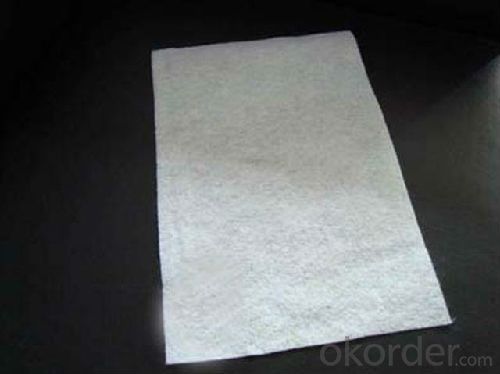
FAQ
Q: What kind of payments does jenor support?
A: T/T, L/C, Cash are accepted.
Q: Do you charge for the samples?
A: Accordeing to our company policy, the samples are freee, we only charge the freight fee. And we will return the freight fee during the next order.
Q: Can you produce according to customers' design?
A: Sure, we are professional manufacturer, OEM and ODM are both welcome.

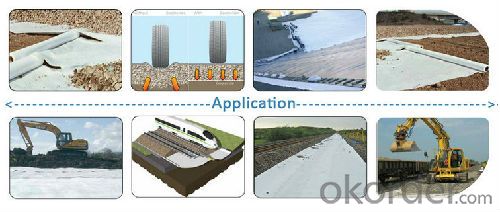
- Q: What are the specifications for geotextiles used in geosynthetic tubes?
- The specifications for geotextiles used in geosynthetic tubes may vary depending on the specific application and project requirements. However, some common specifications include factors such as the tensile strength, permeability, UV resistance, puncture resistance, and filtration properties. It is important to consider the specific project conditions and engineering design to determine the suitable specifications for geotextiles used in geosynthetic tubes.
- Q: Can geotextiles be used in wastewater treatment applications?
- Yes, geotextiles can be used in wastewater treatment applications. They are commonly used in filtration systems to separate solids from liquids and provide support for various treatment processes. Geotextiles can enhance the efficiency of wastewater treatment by improving filtration, reducing clogging, and increasing overall system performance.
- Q: Can geotextiles withstand harsh weather conditions?
- Yes, geotextiles are designed to withstand harsh weather conditions. They are made from durable materials that are resistant to UV rays, moisture, and temperature fluctuations, making them suitable for various environmental conditions. Additionally, geotextiles have high tensile strength and can resist damage caused by heavy rain, wind, and extreme temperatures, ensuring their performance and longevity even in harsh weather conditions.
- Q: What is the difference between polypropylene geotextile, polypropylene geotextile and polyester geotextile
- The raw material is not the same as the clothes have the same cotton polyester tea is the same characteristics of the characteristics of acid-resistant polyester anti-purple better look at where to see where the 4935 penguins
- Q: How do geotextiles help with siltation control in construction sites?
- Geotextiles help with siltation control in construction sites by acting as a barrier that prevents the movement of soil particles while still allowing water to pass through. They are typically placed on the ground surface or used as erosion control blankets, effectively reducing erosion and sediment runoff. This helps to minimize the amount of silt and sediment that enters nearby water bodies, maintaining water quality and protecting the surrounding environment.
- Q: Can geotextiles be used in underground storage tank installations?
- Yes, geotextiles can be used in underground storage tank installations. Geotextiles are often used as a protective barrier between the tank and the surrounding soil to prevent contamination and provide stability.
- Q: Geotextile price geotextile how much money a square meter
- Geotextile is a new type of building materials, raw materials are polyester, polypropylene, acrylic, nylon and other polymer polymer synthetic fiber. In accordance with the manufacturing method is divided into: there are two types of geotextile and non-woven geotextile. According to the use of anti-seepage, anti-filter, drainage, isolation, reinforcement, protection, sealing and so on a variety of functions, based on a variety of factors, the price is not the same, we would rather discuss with the price, Hongxiang new materials company Meng Xiangyu that sell products is not just look at profits, if only the simple pursuit of profit level, it is too easy, but if you want to assume the responsibility of the consumer, the quality of the project Responsibility, but need to spend a lot of effort. To this end, we do not count the cost, put a lot of manpower and resources to innovation, to transform, choose the best materials and the best modern equipment, put a lot of manpower, material resources to innovation, to create brand value, Can create the greatest green benefits. High-end quality and green is a commitment, we promise not to short-term interests, betray the future!
- Q: Can geotextiles be used in pond and lake liners?
- Yes, geotextiles can be used in pond and lake liners. They are often used as a protective layer to prevent punctures and abrasions in the liner material, and to enhance the overall stability and durability of the liner system. Geotextiles can also improve filtration and drainage properties, helping to maintain the quality and functionality of the water body.
- Q: Can geotextiles be used in the construction of artificial islands?
- Yes, geotextiles can be used in the construction of artificial islands. Geotextiles are commonly used in civil engineering projects for their ability to provide soil stabilization, erosion control, and drainage. In the construction of artificial islands, geotextiles can be used as a barrier to prevent soil erosion, reinforce embankments, and promote the establishment of vegetation. They can also help with filtration and separation of different materials during the island building process.
- Q: What are the advantages of using geotextiles in shoreline stabilization?
- There are several advantages of using geotextiles in shoreline stabilization. Firstly, geotextiles act as a barrier that prevents erosion and protects the shoreline from wave action. They provide stability to the soil by providing reinforcement and preventing the loss of sediment. Additionally, geotextiles allow for the filtration of water, which helps to maintain water quality and prevent the buildup of sediment. Furthermore, geotextiles are cost-effective compared to traditional methods of shoreline stabilization, as they require less maintenance and can be easily installed. Overall, geotextiles offer a sustainable and environmentally friendly solution for shoreline stabilization.
1. Manufacturer Overview
| Location | Taian City,Shandong Province,China |
| Year Established | 2008 |
| Annual Output Value | Above US$100 Million |
| Main Markets | Africa, Oceania, North America, Western Europe, Eastern Asia |
| Company Certifications | ISO9001;IS014001 Certificate |
2. Manufacturer Certificates
| a) Certification Name | |
| Range | |
| Reference | |
| Validity Period |
3. Manufacturer Capability
| a) Trade Capacity | |
| Nearest Port | Qingdao Port;Tianjing Port;Shanghai Port |
| Export Percentage | |
| No.of Employees in Trade Department | 21-30 People |
| Language Spoken: | English; Chinese; |
| b) Factory Information | |
| Factory Size: | 10,000-30,000 square meters |
| No. of Production Lines | Above 10 |
| Contract Manufacturing | Geotechnical Material (Geogrid,Fiberglass/Polyester Geogrid,Geocell,Geonet and Geomat,Plastic Safety Fence) |
| Product Price Range | Average |
Send your message to us
Geotextil 4m Short Fiber and Geomembrane Composite Waterproofing Membrane
- Loading Port:
- Qingdao
- Payment Terms:
- TT or L/C
- Min Order Qty:
- 10000 m²
- Supply Capability:
- 10000 m²/month
OKorder Service Pledge
OKorder Financial Service
Similar products
Hot products
Hot Searches
Related keywords





